Neuronal expression of a single-subunit yeast NADH-ubiquinone oxidoreductase (Ndi1) extends Drosophila lifespan
- PMID: 20089120
- PMCID: PMC2860002
- DOI: 10.1111/j.1474-9726.2010.00546.x
Neuronal expression of a single-subunit yeast NADH-ubiquinone oxidoreductase (Ndi1) extends Drosophila lifespan
Abstract
The 'rate of living' theory predicts that longevity should be inversely correlated with the rate of mitochondrial respiration. However, recent studies in a number of model organisms, including mice, have reported that interventions that retard the aging process are, in fact, associated with an increase in mitochondrial activity. To better understand the relationship between energy metabolism and longevity, we supplemented the endogenous respiratory chain machinery of the fruit fly Drosophila melanogaster with the alternative single-subunit NADH-ubiquinone oxidoreductase (Ndi1) of the baker's yeast Saccharomyces cerevisiae. Here, we report that expression of Ndi1 in fly mitochondria leads to an increase in NADH-ubiquinone oxidoreductase activity, oxygen consumption, and ATP levels. In addition, exogenous Ndi1 expression results in increased CO2 production in living flies. Using an inducible gene-expression system, we expressed Ndi1 in different cells and tissues and examined the impact on longevity. In doing so, we discovered that targeted expression of Ndi1 in fly neurons significantly increases lifespan without compromising fertility or physical activity. These findings are consistent with the idea that enhanced respiratory chain activity in neuronal tissue can prolong fly lifespan.
Figures

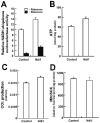
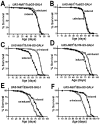
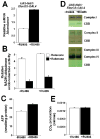

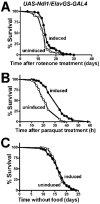
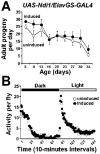
Similar articles
-
Expression of the yeast NADH dehydrogenase Ndi1 in Drosophila confers increased lifespan independently of dietary restriction.Proc Natl Acad Sci U S A. 2010 May 18;107(20):9105-10. doi: 10.1073/pnas.0911539107. Epub 2010 Apr 30. Proc Natl Acad Sci U S A. 2010. PMID: 20435911 Free PMC article.
-
Increased longevity mediated by yeast NDI1 expression in Drosophila intestinal stem and progenitor cells.Aging (Albany NY). 2013 Sep;5(9):662-81. doi: 10.18632/aging.100595. Aging (Albany NY). 2013. PMID: 24038661 Free PMC article.
-
Gene therapy of yeast NDI1 on mitochondrial complex I dysfunction in rotenone-induced Parkinson's disease models in vitro and vivo.Mol Med. 2022 Mar 7;28(1):29. doi: 10.1186/s10020-022-00456-x. Mol Med. 2022. PMID: 35255803 Free PMC article.
-
Alternative respiratory oxidases to study the animal electron transport chain.Biochim Biophys Acta Bioenerg. 2023 Jan 1;1864(1):148936. doi: 10.1016/j.bbabio.2022.148936. Epub 2022 Nov 14. Biochim Biophys Acta Bioenerg. 2023. PMID: 36395975 Review.
-
Possibility of transkingdom gene therapy for complex I diseases.Biochim Biophys Acta. 2006 May-Jun;1757(5-6):708-14. doi: 10.1016/j.bbabio.2006.01.011. Epub 2006 Feb 24. Biochim Biophys Acta. 2006. PMID: 16581014 Review.
Cited by
-
NADH-dehydrogenase type-2 suppresses irreversible visual loss and neurodegeneration in the EAE animal model of MS.Mol Ther. 2013 Oct;21(10):1876-88. doi: 10.1038/mt.2013.104. Epub 2013 Jun 11. Mol Ther. 2013. PMID: 23752309 Free PMC article.
-
Complex-I-ty in aging.J Bioenerg Biomembr. 2014 Aug;46(4):329-35. doi: 10.1007/s10863-014-9553-0. Epub 2014 Jun 25. J Bioenerg Biomembr. 2014. PMID: 24961226 Free PMC article. Review.
-
Noncoupled Mitochondrial Respiration as Therapeutic Approach for the Treatment of Metabolic Diseases: Focus on Transgenic Animal Models.Int J Mol Sci. 2023 Nov 18;24(22):16491. doi: 10.3390/ijms242216491. Int J Mol Sci. 2023. PMID: 38003681 Free PMC article. Review.
-
Organ-specific mediation of lifespan extension: more than a gut feeling?Ageing Res Rev. 2013 Jan;12(1):436-44. doi: 10.1016/j.arr.2012.05.003. Epub 2012 Jun 15. Ageing Res Rev. 2013. PMID: 22706186 Free PMC article. Review.
-
Transcript and protein expression decoupling reveals RNA binding proteins and miRNAs as potential modulators of human aging.Genome Biol. 2015 Feb 22;16(1):41. doi: 10.1186/s13059-015-0608-2. Genome Biol. 2015. PMID: 25853883 Free PMC article.
References
-
- Balaban RS, Nemoto S, Finkel T. Mitochondria, oxidants, and aging. Cell. 2005;120:483–495. - PubMed
-
- Barros MH, Bandy B, Tahara EB, Kowaltowski AJ. Higher respiratory activity decreases mitochondrial reactive oxygen release and increases life span in Saccharomyces cerevisiae. J Biol Chem. 2004;279:49883–49888. - PubMed
-
- Bauer JH, Poon PC, Glatt-Deeley H, Abrams JM, Helfand SL. Neuronal expression of p53 dominant-negative proteins in adult Drosophila melanogaster extends life span. Curr Biol. 2005;15:2063–2068. - PubMed
-
- Bishop NA, Guarente L. Two neurons mediate diet-restriction-induced longevity in C. elegans. Nature. 2007;447:545–549. - PubMed
-
- Bluher M, Kahn BB, Kahn CR. Extended longevity in mice lacking the insulin receptor in adipose tissue. Science. 2003;299:572–574. - PubMed
Publication types
MeSH terms
Substances
Grants and funding
LinkOut - more resources
Full Text Sources
Molecular Biology Databases

